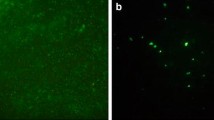Abstract
Pseudomonas aeruginosa, an opportunistic human pathogen, causes many biofilm-mediated chronic infections. In this study, biofilm structures of various clinical strains of P. aeruginosa isolated from hospitalized patients were examined and their influence on the biofilm-dispersing effects of chemicals was investigated. The clinical isolates formed structurally distinct biofilms that could be classified into three different groups: 1) mushroom-like, 2) thin flat, and 3) thick flat structures. A dispersion of these differently structured biofilms was induced using two biofilm-dispersing agents, anthranilate and sodium nitroprusside (SNP). Although both SNP and anthranilate could disperse all types of biofilms, the thick flat biofilms were dispersed less efficiently than the biofilms of other structures. This suggests that biofilm-dispersing agents have higher potency on the biofilms of porous structures than on densely packed biofilms.
Similar content being viewed by others
References
Banin, E., Brady, K.M., and Greenberg, E.P. 2006. Chelator-induced dispersal and killing of Pseudomonas aeruginosa cells in a biofilm. Appl. Environ. Microbiol. 72, 2064–2069.
Barraud, N., Schleheck, D., Klebensberger, J., Webb, J.S., Hassett, D.J., Rice, S.A., and Kjelleberg, S. 2009. Nitric oxide signaling in Pseudomonas aeruginosa biofilms mediates phosphodiesterase activity, decreased cyclic di-GMP levels, and enhanced dispersal. J. Bacteriol. 191, 7333–7342.
Chung, I.Y., Choi, K.B., Heo, Y.J., and Cho, Y.H. 2008. Effect of PEL exopolysaccharide on the wspF mutant phenotypes in Pseudomonas aeruginosa PA14. J. Microbiol. Biotechnol. 18, 1227–1234.
Colvin, K.M., Gordon, V.D., Murakami, K., Borlee, B.R., Wozniak, D.J., Wong, G.C.L., and Parsek, M.R. 2011. The pel polysaccharide can serve a structural and protective role in the biofilm matrix of Pseudomonas aeruginosa. PLoS Pathog. 7, e1001264.
Costerton, J.W., Stewart, P.S., and Greenberg, E.P. 1999. Bacterial biofilms: A common cause of persistent infections. Science 284, 1318–1322.
Davies, D. 2003. Understanding biofilm resistance to antibacterial agents. Nat. Rev. Drug Discov. 2, 114–122.
Donlan, R.M. 2001. Biofilms and device-associated infections. Emerg. Infect. Dis. 7, 277–281.
Ghafoor, A., Hay, I.D., and Rehm, B.H. 2011. Role of exopolysaccharides in Pseudomonas aeruginosa biofilm formation and architecture. Appl. Environ. Microbiol. 77, 5238–5246.
Hancock, R.E. and Speert, D.P. 2000. Antibiotic resistance in Pseudomonas aeruginosa: Mechanisms and impact on treatment. Drug Resist. Updat. 3, 247–255.
Head, N.E. and Yu, H.W. 2004. Cross-sectional analysis of clinical and environmental isolates of Pseudomonas aeruginosa: Biofilm formation, virulence, and genome diversity. Infect. Immun. 72, 133–144.
Hickman, J.W., Tifrea, D.F., and Harwood, C.S. 2005. A chemosensory system that regulates biofilm formation through modulation of cyclic diguanylate levels. Proc. Natl. Acad. Sci. USA 102, 14422–14427.
Jung, K.J., Choi, Y., Ha, C., Shin, J.H., and Lee, J.H. 2010. Analysis of quorum sensing-related phenotypes of Pseudomonas aeruginosa clinical isolates. Korean J. Microbiol. 6, 240–247.
Jung, Y.G., Choi, J., Kim, S.K., Lee, J.H., and Kwon, S. 2015. Embedded biofilm, a new biofilm model based on the embedded growth of bacteria. Appl. Environ. Microbiol. 81, 211–219.
Karatan, E. and Watnick, P. 2009. Signals, regulatory networks, and materials that build and break bacterial biofilms. Microbiol. Mol. Biol. Rev. 73, 310–347.
Kim, S.K. and Lee, J.H. 2016. Biofilm dispersion in Pseudomonas aeruginosa. J. Microbiol. 54, 71–85.
Kim, S.K., Park, H.Y., and Lee, J.H. 2015. Anthranilate deteriorates the structure of Pseudomonas aeruginosa biofilms and antagonizes the biofilm-enhancing indole effect. Appl. Environ. Microbiol. 81, 2328–2338.
Kirisits, M.J. and Parsek, M.R. 2006. Does Pseudomonas aeruginosa use intercellular signalling to build biofilm communities? Cell. Microbiol. 8, 1841–1849.
Klausen, M., Heydorn, A., Ragas, P., Lambertsen, L., Aaes-Jorgensen, A., Molin, S., and Tolker-Nielsen, T. 2003. Biofilm formation by Pseudomonas aeruginosa wild type, flagella and type IV pili mutants. Mol. Microbiol. 48, 1511–1524.
Kumar, C.G. and Anand, S.K. 1998. Significance of microbial biofilms in food industry: A review. Int. J. Food Microbiol. 42, 9–27.
Lee, B., Haagensen, J.A., Ciofu, O., Andersen, J.B., Hoiby, N., and Molin, S. 2005. Heterogeneity of biofilms formed by nonmucoid Pseudomonas aeruginosa isolates from patients with cystic fibrosis. J. Clin. Microbiol. 43, 5247–5255.
Li, X.H., Kim, S.K., and Lee, J.H. 2017. Anti-biofilm effects of anthranilate on a broad range of bacteria. Sci. Rep. 7, 8604.
Li, X.H. and Lee, J.H. 2017. Antibiofilm agents: A new perspective for antimicrobial strategy. J. Microbiol. 55, 753–766.
Lima, J., Alves, L.R., Paz, J., Rabelo, M.A., Maciel, M.A.V., and Morais, M.M.C. 2017. Analysis of biofilm production by clinical isolates of Pseudomonas aeruginosa from patients with ventilator-associated pneumonia. Rev. Bras. Ter. Intensiva 29, 310–316.
Parsek, M.R. and Greenberg, E.P. 2005. Sociomicrobiology: The connections between quorum sensing and biofilms. Trends Microbiol. 13, 27–33.
Pearson, J.P., Pesci, E.C., and Iglewski, B.H. 1997. Roles of Pseudomonas aeruginosa las and rhl quorum-sensing systems in control of elastase and rhamnolipid biosynthesis genes. J. Bacteriol. 179, 5756–5767.
Sauer, K., Camper, A.K., Ehrlich, G.D., Costerton, J.W., and Davies, D.G. 2002. Pseudomonas aeruginosa displays multiple phenotypes during development as a biofilm. J. Bacteriol. 184, 1140–1154.
Sauer, K., Cullen, M.C., Rickard, A.H., Zeef, L.A., Davies, D.G., and Gilbert, P. 2004. Characterization of nutrient-induced dispersion in Pseudomonas aeruginosa PAO1 biofilm. J. Bacteriol. 186, 7312–7326.
Schleheck, D., Barraud, N., Klebensberger, J., Webb, J.S., McDougald, D., Rice, S.A., and Kjelleberg, S. 2009. Pseudomonas aeruginosa PAO1 preferentially grows as aggregates in liquid batch cultures and disperses upon starvation. PLoS One 4, e5513.
Simm, R., Morr, M., Kader, A., Nimtz, M., and Romling, U. 2004. GGDEF and EAL domains inversely regulate cyclic di-GMP levels and transition from sessility to motility. Mol. Microbiol. 53, 1123–1134.
Spiers, A.J., Bohannon, J., Gehrig, S.M., and Rainey, P.B. 2003. Biofilm formation at the air-liquid interface by the Pseudomonas fluorescens SBW25 wrinkly spreader requires an acetylated form of cellulose. Mol. Microbiol. 50, 15–27.
Willcox, M.D., Zhu, H., Conibear, T.C., Hume, E.B., Givskov, M., Kjelleberg, S., and Rice, S.A. 2008. Role of quorum sensing by Pseudomonas aeruginosa in microbial keratitis and cystic fibrosis. Microbiology 154, 2184–2194.
Author information
Authors and Affiliations
Corresponding author
Rights and permissions
About this article
Cite this article
Kim, SK., Li, XH., Hwang, HJ. et al. Antibiofilm effect of biofilm-dispersing agents on clinical isolates of Pseudomonas aeruginosa with various biofilm structures. J Microbiol. 56, 902–909 (2018). https://doi.org/10.1007/s12275-018-8336-4
Received:
Revised:
Accepted:
Published:
Issue Date:
DOI: https://doi.org/10.1007/s12275-018-8336-4




